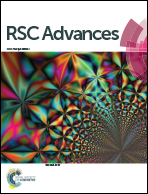Novel optical characteristics of Eu2+ doped and Eu2+, Ce3+ co-doped LiSi2N3 phosphors by gas-pressed sintering
Abstract
Eu2+ doped and Eu2+, Ce3+ co-doped LiSi2N3 phosphors were successfully prepared by gas-pressed sintering in this study. The dominant excitation band of LiSi2N3:Eu2+ was found at about 355 nm and exhibited a broad-band yellow emission centered at 592 nm instead of the early reports of 310 nm and 580 nm, respectively. The shifting behavior dominantly contributed to different oxygen content in the host. The second luminescent center formed by the introduction of oxygen into nitride phosphors was discussed in detail. The detailed energy transfer mechanism from Ce3+ to Eu2+ in the LiSi2N3 host is also reported and a notable unusual redshift behavior was observed in Eu2+, Ce3+ co-doped LiSi2N3 phosphors.


 Please wait while we load your content...
Please wait while we load your content...